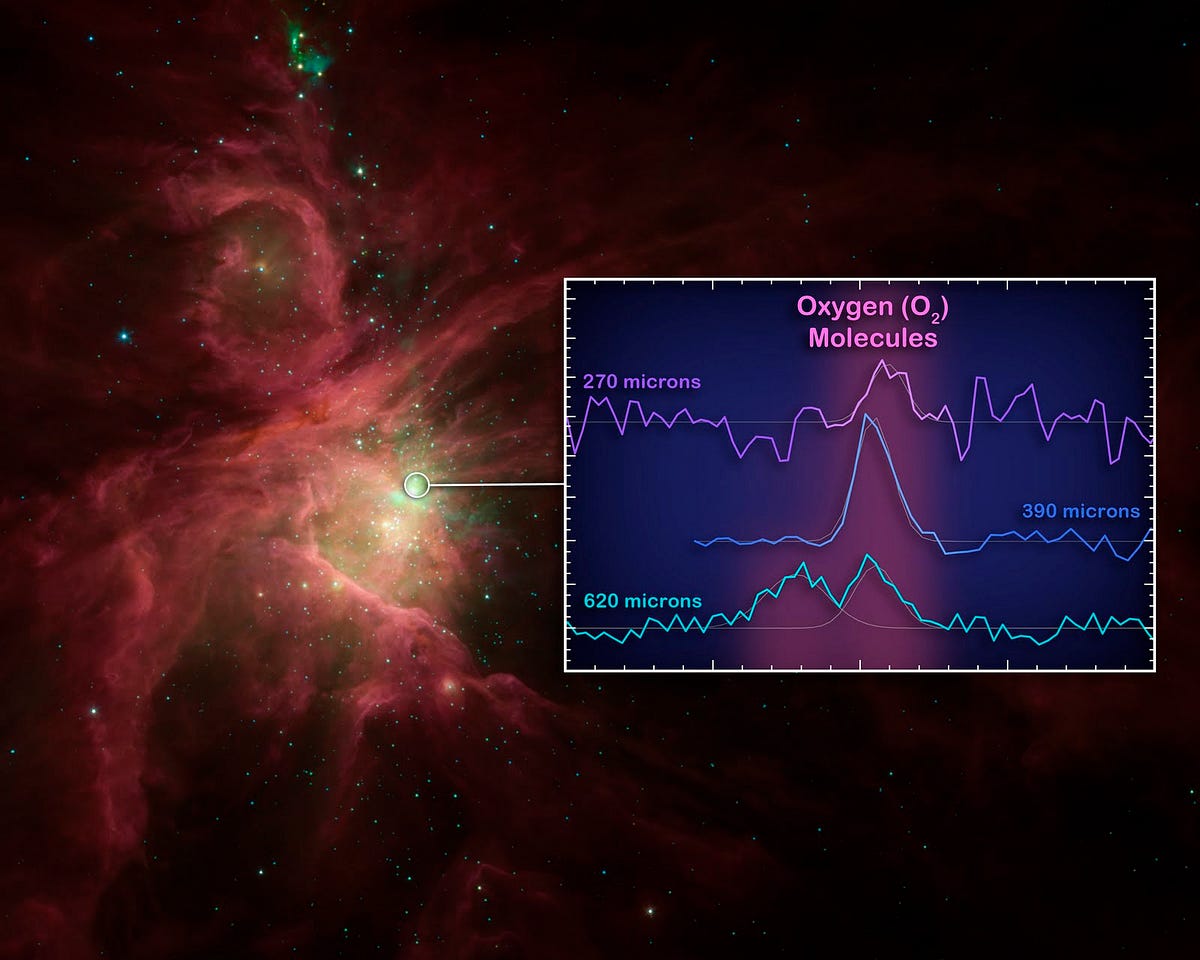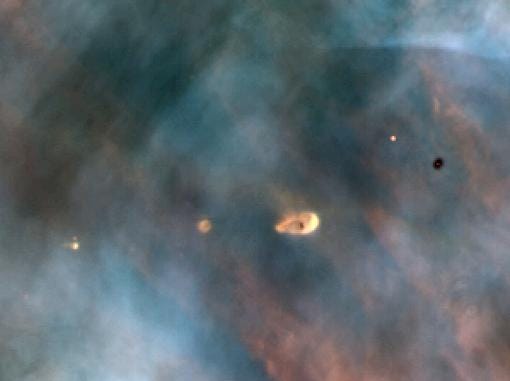Messier Monday: The Great Orion Nebula, M42
The greatest Messier object of them all, a treat all winter long.
“What caused me to undertake the catalog was the nebula I discovered above the southern horn of Taurus on September 12, 1758, while observing the comet of that year. … This nebula had such a resemblance to a comet in its form and brightness that I endeavored to find others, so that astronomers would not confuse these same nebulae with comets just beginning to shine.” -Charles Messier
When you look up at the night sky, in addition to all the stars that you see, a keen and dedicated observer can notice open star clusters globular clusters, galaxies and nebulae littered among the night sky. The first accurate catalogue of many of the brightest such fixtures — the Messier catalogue — boasts of 110 deep-sky wonders, many of which are visible to the naked eye.
Yet among the nebulae, there’s only one.

In the prominent constellation of Orion — visible all winter long after the Sun sets — even skywatchers with very little experience can locate the Great Orion Nebula. Let’s show you how, and then let’s uncover its secrets!

After the Sun goes down at this time of year, skywatchers worldwide can see a selection of the brightest stars in the sky — four of the top ten, including Sirius (#1), Rigel (#7), Procyon (#8) and Betelgeuse (#9) (with Aldebaran (#14) almost making the cut) — rising in the East and passing highest above the horizon in the South. Orion is highlighted by the three stars along its belt, with bright orange Betelgeuse more northerly and bright blue Rigel more southerly.
It’s the southern side of the belt you need to be looking on to find the 42nd object in Messier’s catalogue: the Orion Nebula.

Even from heavily light-polluted cities, Orion’s belt is clearly visible to the naked eye, and south of it you can see what appear to be three points of light. What’s unusual about this is that even people with flawless vision see that these three star-like objects might appear to be a bit blurred, something highly unusual.
It’s not your eyes playing tricks on you; it’s the fact that there really is something blurring what you’re seeing. What is this, exactly?

It’s the Great Orion Nebula, also known as Messier 42. It’s a rewarding experience to observe in binoculars or a telescope of any size; to Messier, it appeared as:
Position of the beautiful nebula in the sword of Orion, around the star Theta which it contains [together] with three other smaller stars which one cannot see but with good instruments.
Through Messier’s optics, he likely saw a sight similar to this.

But there’s so much more to see with modern technology. Even an amateur with modest equipment (and a bit of experience) can truly bring out an incredible amount of detail in this region of space. Let’s see what we’ve got.

First off, you’ll notice the brilliant reddish color of the nebula. That comes from ionized hydrogen gas, which emits a characteristic red emission line when electrons fall back down in the orbitals of hydrogen atoms. This is a telltale sign of star-forming regions, and the Orion Nebula is the closest one to Earth in the entire Universe!
Located about 1,344 light-years away, the Orion Nebula proper is only about 24 light-years across. But I throw “proper” in there as a qualifier for a reason: there’s a great molecular cloud complex that spans hundreds of light-years in diameter, and the Orion Nebula is only the most prominent component of that!

These bright blue stars found near it are due to the fact that star formation has occurred in this neighborhood very recently over the past few tens of millions of years, and is still ongoing in a great many spots.
Most prominently, that’s what’s happening in the Orion Nebula. The identification of a star cluster inside it — dating all the way back to Galileo — was the “smoking gun” that we’d look for to prove it.

There are around some 2,000 stars identified to date in the Orion Nebula, many of which appear reddened by the presence of foreground dust that blocks the light. In addition, there are parts of the nebulous regions that turn blue as they reflect the starlight from the bright, hot young stars that outshine the dimmer ones.
Even some 25 light-years away from the edge of the Orion Nebula proper, the Running Man Nebula — a part of the same cloud complex — is lit up prominently if you do long-exposure photography.

If you’ve ever seen a pink region in another galaxy or a more distant star-forming region, it’s very likely been larger and far more spectacular than the Orion Nebula; the only reason the Orion Nebula is so wondrous to us is because it’s so close.
But its close proximity to us does much, much more than merely give us spectacular views, it also gives us an incredible opportunity to learn about the science of how star-forming regions work!

We’ve discovered a number of interesting elements in the nebula, including a rare state of doubly-ionized oxygen that glows green, molecular oxygen, and a number of unique features in the gas itself. I say unique not because they’re not suspected to be elsewhere, but unique because many of these features are only seen — or are only seen prominently — in the Orion Nebula due to its close proximity to us!

For example, here is an animation showing the motion of gas outflowing from a special class of object known as a Herbig-Haro object. These images were taken over a five year timespan, and span about a tenth of a light-year across.
We’ve also found the very first direct evidence of protoplanetary disks in this nebula!

But there’s so much to see in here that I couldn’t possibly do it justice. So let’s just summarize with a few of the most spectacular highlights to ever come about.

First, the incredible high-resolution images taken by the European Southern Observatory show us (top left) the Trapezium cluster, the same one discovered by Galileo. On the top right, you’ll see “ripples” in the gas of the nebula, and that’s caused by the intense ultraviolet radiation coming from the Trapezium cluster: that’s the Kelvin-Helmholtz instability in action creating these wavy shapes! (Notice also there’s an edge-on spiral galaxy visible far behind it.) The bottom two panels show stars practically invisible to optical wavelengths, but the infrared camera used to probe this region really brings out not only the stars, but also the structure of the interstellar medium!
But there’s one view that I found even more spectacular that these, and it highlights the very edges and limits of the Orion Nebula.

These “Orion bullets” are new stars burning off the columns of gas — evaporating gaseous globules — that they were created from! The resolution on these images is absolutely incredible: at a tenth of an arcsecond, it would take some 1.3 billion pixels to view the entire nebula with this degree of precision!
And finally, for those of you who were wondering about where this nebula fits in with Orion, anatomically, it is traditionally referred to as his “sword,” as it hangs down off of his belt.
But no one’s buying it.

And that’s going to wrap up today’s Messier Monday, and perhaps the greatest Messier Monday of all-time! Including today, here are the ones we’ve covered so far:
- M1, The Crab Nebula: October 22, 2012
- M2, Messier’s First Globular Cluster: June 17, 2013
- M5, A Hyper-Smooth Globular Cluster: May 20, 2013
- M7, The Most Southerly Messier Object: July 8, 2013
- M8, The Lagoon Nebula: November 5, 2012
- M11, The Wild Duck Cluster: September 9, 2013
- M12, The Top-Heavy Gumball Globular: August 26, 2013
- M13, The Great Globular Cluster in Hercules: December 31, 2012
- M15, An Ancient Globular Cluster: November 12, 2012
- M18, A Well-Hidden, Young Star Cluster: August 5, 2013
- M20, The Youngest Star-Forming Region, The Trifid Nebula: May 6, 2013
- M21, A Baby Open Cluster in the Galactic Plane: June 24, 2013
- M25, A Dusty Open Cluster for Everyone: April 8, 2013
- M29, A Young Open Cluster in the Summer Triangle: June 3, 2013
- M30, A Straggling Globular Cluster: November 26, 2012
- M31, Andromeda, the Object that Opened Up the Universe: September 2, 2013
- M32, The Smallest Messier Galaxy: November 4, 2013
- M33, The Triangulum Galaxy: February 25, 2013
- M34, A Bright, Close Delight of the Winter Skies: October 14, 2013
- M36, A High-Flying Cluster in the Winter Skies: November 18, 2013
- M37, A Rich Open Star Cluster: December 3, 2012
- M38, A Real-Life Pi-in-the-Sky Cluster: April 29, 2013
- M39, The Closest Messier Original: November 11, 2013
- M40, Messier’s Greatest Mistake: April 1, 2013
- M41, The Dog Star’s Secret Neighbor: January 7, 2013
- M42, The Great Orion Nebula: February 3, 2014
- M44, The Beehive Cluster / Praesepe: December 24, 2012
- M45, The Pleiades: October 29, 2012
- M46, The ‘Little Sister’ Cluster: December 23, 2013
- M47, A Big, Blue, Bright Baby Cluster: December 16, 2013
- M48, A Lost-and-Found Star Cluster: February 11, 2013
- M50, Brilliant Stars for a Winter’s Night: December 2, 2013
- M51, The Whirlpool Galaxy: April 15th, 2013
- M52, A Star Cluster on the Bubble: March 4, 2013
- M53, The Most Northern Galactic Globular: February 18, 2013
- M56, The Methuselah of Messier Objects: August 12, 2013
- M57, The Ring Nebula: July 1, 2013
- M60, The Gateway Galaxy to Virgo: February 4, 2013
- M63, The Sunflower Galaxy: January 6, 2014
- M65, The First Messier Supernova of 2013: March 25, 2013
- M66, The King of the Leo Triplet: January 27, 2014
- M67, Messier’s Oldest Open Cluster: January 14, 2013
- M71, A Very Unusual Globular Cluster: July 15, 2013
- M72, A Diffuse, Distant Globular at the End-of-the-Marathon: March 18, 2013
- M73, A Four-Star Controversy Resolved: October 21, 2013
- M74, The Phantom Galaxy at the Beginning-of-the-Marathon: March 11, 2013
- M75, The Most Concentrated Messier Globular: September 23, 2013
- M77, A Secretly Active Spiral Galaxy: October 7, 2013
- M78, A Reflection Nebula: December 10, 2012
- M79, A Cluster Beyond Our Galaxy: November 25, 2013
- M81, Bode’s Galaxy: November 19, 2012
- M82, The Cigar Galaxy: May 13, 2013
- M83, The Southern Pinwheel Galaxy, January 21, 2013
- M86, The Most Blueshifted Messier Object, June 10, 2013
- M92, The Second Greatest Globular in Hercules, April 22, 2013
- M93, Messier’s Last Original Open Cluster, January 13, 2014
- M94, A double-ringed mystery galaxy, August 19, 2013
- M95, A Barred Spiral Eye Gazing At Us, January 20, 2014
- M96, A Galactic Highlight to Ring in the New Year, December 30, 2013
- M97, The Owl Nebula, January 28, 2013
- M99, The Great Pinwheel of Virgo, July 29, 2013
- M101, The Pinwheel Galaxy, October 28, 2013
- M102, A Great Galactic Controversy: December 17, 2012
- M103, The Last ‘Original’ Object: September 16, 2013
- M104, The Sombrero Galaxy: May 27, 2013
- M106, A Spiral with an Active Black Hole: December 9, 2013
- M108, A Galactic Sliver in the Big Dipper: July 22, 2013
- M109, The Farthest Messier Spiral: September 30, 2013
Come back and join us next week for another deep-sky wonder and another story that the Universe tells us about itself, only here on Messier Monday!





